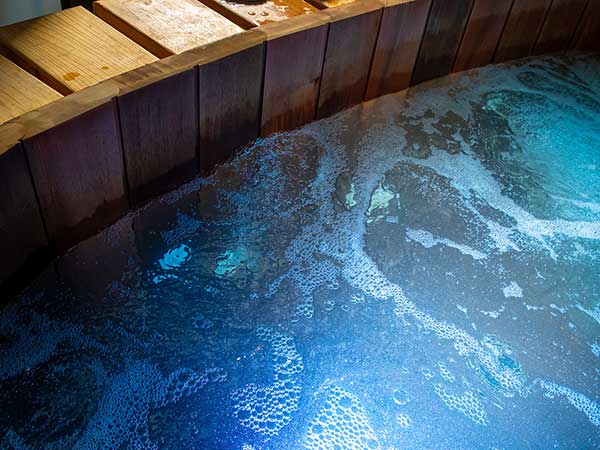
Ozone and Ionisation Sanitisation Systems
We offer sanitisation systems that are 100% halogen-free with no chlorine or bromine using two of nature’s most powerful cleaners OZONE and IONISATION, our tubs can be used safely while producing the cleanest water available. Using a combination of both systems provides the best and most effective water management. This dramatically reduces the need for chlorine and bromine.
How often do you need to change the water in a Cedar Wood Hot Tub?
Maintaining clean and clear water in your Cedar Wood Hot Tub is essential for enjoying a safe and comfortable soaking experience. One of the most important factors in water maintenance is how often you need to change the water in your tub.
Depending on how much you use the hot tub and how many people use it, the water should be changed regularly. This could be anything from once a week, to once every three months. Factors such as bather load, water chemistry, and environmental conditions can also impact how often you should change the water in your Cedar Wood Hot Tub. For example, if you use your hot tub more frequently or have a higher bather load, you may need to change the water more often. It's important to note that regular maintenance, such as testing and balancing the water chemistry, can help extend the time between water changes.
Ultimately, it's best to monitor the condition of the water in your Cedar Wood Hot Tub and change it as needed to ensure a safe and enjoyable soaking experience.
Maintaining the Chemical Balance
One of the most important aspects of owning a Cedar Wood Hot Tub is maintaining the chemical balance. Proper water maintenance not only keeps the water safe and comfortable to soak in but also helps extend the lifespan of the hot tub.
Here are some tips for maintaining the water quality and chemical balance in your Cedar Wood Hot Tub:
- Shower before use: Bathers should not use any oils or cosmetics before using the Cedar hot tub because this clogs the filters and throws out the chemical balance of the water. It is recommended that bathers shower before using the Cedar hot tub.
- Test the Water: Regularly test the water in your Cedar Wood Hot Tub using a water testing kit to ensure it's balanced and safe. Test for pH, alkalinity, chlorine or bromine levels, and calcium hardness. See the table below.
- Adjust Chemicals: Once you have tested the water, adjust the chemicals as needed to achieve the proper levels. Add chemicals gradually and wait for them to dissolve before retesting.
- Clean the Filter: The filter in your Cedar Wood Hot Tub helps remove impurities from the water. Clean the filter regularly, following the manufacturer's instructions. A dirty filter can lead to cloudy water and poor water quality.
- Use the hot tub cover: Keep your Cedar Hot Tub covered when not in use to keep out debris and avoid accidental drowning.
- Drain and Refill the Water: As mentioned earlier, it's recommended to change the water in your Cedar Wood Hot Tub regularly. Draining and refilling the water is an essential part of maintaining water quality and chemical balance.
By following these tips and regularly maintaining the water quality and chemical balance, you can ensure a safe and enjoyable soaking experience in your Cedar Wood Hot Tub.
Water Quality Charts
| Minimum | Target | Maximum | |
|---|---|---|---|
| PH | 7.2 | 7.4 | 7.8 |
| Alkalinity | 40ppm | 80ppm | 120ppm |
| Hardness | 50ppm | 100ppm | 150ppm |
| Bromine | 1ppm | 3ppm | 5ppm |
| ACIDIC (Corrosive) | Comfort Zone | Alkaline (Scaling) | |
|---|---|---|---|
| PH | 6.8 | 7.2 to 7.6 | 7.8 to 8.2 |
| Action | Add pH Increaser | Ideal | Add pH Decreaser |
Water Terminology
Understanding the meaning of these chemical terms will help you to better understand the water maintenance process
Bromamines
These are compounds formed when bromine combines with nitrogen from body oils, urine, perspiration, etc. Unlike chloramines, bromamines have no pungent odour and are effective sanitizers.
Bromine
A halogen sanitizer (in the same chemical family as chlorine). Bromine is commonly used in stick, tablet, or granular form.
Calcium Hardness
The amount of dissolved calcium in the spa water. This should be approximately 50 -150 ppm (ACE: 25 – 75 ppm). High levels of calcium can cause cloudy water and scaling. Low levels can cause harm to the spa equipment.
Chloramines
Compounds formed when chlorine combines with nitrogen from body oils, urine, perspiration, etc. Chloramines can cause eye irritation as well as have a strong odour. Unlike bromamines, chloramines are weaker, slower sanitizers.
Chlorine
An efficient sanitizing chemical for spas. We recommend the use of sodium dichlor-type granulated chlorine. This type is preferred because it is totally soluble and nearly pH neutral.
Chlorine (or Bromine) Residual
The amount of chlorine or bromine remaining after chlorine or bromine demand has been satisfied. The residual is, therefore, the amount of sanitizer which is chemically available to kill bacteria, viruses, and algae.
Corrosion
The gradual wearing away of metal and plastic spa parts, usually caused by chemical action. Generally, corrosion is caused by low pH or by water with levels of TA, CH, pH, or sanitizer which are outside the recommended ranges.
Halogen
Any one of these five elements: fluorine, chlorine, bromine, iodine, and astatine.
MPS
Monopersulphate is the non-chlorine oxidiser used with the FRESHWATERAG+ silver ion purification system as a shock alternative. It is not a sanitiser.
Nitric Acid
The formulation of nitric acid, a highly corrosive chemical, is a by-product of the ozone generating process. Nitric acid is produced in very small quantities and is readily dissolved in the water stream with ozone.
Oxidizer
The use of an oxidizing chemical is to prevent the build-up of contaminants, maximize sanitizer efficiency, minimize combined chlorine and improve water clarity. See MPS and Ozone.
Ozone
Ozone is a powerful oxidizing agent which is produced in nature and artificially by man. Ozone forms no by-products oxidizes chloramines, and will not alter the water’s pH.
pH
The measure of the spa water’s acidity and alkalinity. The recommended pH for the spa water is 7.2 to 7.8. Below 7.0 (considered neutral), the spa water is too acidic and can damage the heating system. Above 7.8, the water is too alkaline and can result in cloudy water, and scale formation on the shell and heater.
ppm
The abbreviation of “parts per million”, the standard measurement of chemical concentration in water. Identical to mg/l (milligrams per litre).
Reagent
A chemical material in liquid, powder, or tablet form for use in chemical testing.
Sanitiser
Sanitisers are added and maintained at recommended residuals to protect bathers against pathogenic organisms (such as bacteria or viruses) which can cause disease and infection in spa water.
Scale
Rough calcium-bearing deposits that can coat spa surfaces, heaters, plumbing lines, and clog filters. Generally, scaling is caused by mineral content combined with high pH. Additionally, scale forms more readily at higher water temperatures.
Super-Chlorination
Also known as “shock treatment.” Super-Chlorination is a process of adding significant doses of a quick-dissolving sanitizer (“dichlor” is recommended) to oxidize non-filterable organic waste and remove chloramines and bromamines.
Total Alkalinity (TA)
The amount of bicarbonates, carbonates, and hydroxides present in spa water. Proper total alkalinity is important for pH control. If the TA is too high, the pH is difficult to adjust. If the TA is too low, the pH will be difficult to hold at the proper level. The desired range of TA in spa water is 40 to 120 ppm.
Recent Posts
Boost Your Airbnb Business
The Commercial Benefits of Cedar Wood Hot Tubs in the Hospitality Sector In the competitive landscape of the hospitality industry, providing unique and memorable experiences for guests is key to success. [...]
Sauna Therapy: Benefits for Mind and Body
In a world that moves at an ever-increasing pace, finding moments of true relaxation and rejuvenation has become a rare luxury. This is where the age-old practice of sauna therapy comes in, offering [...]
The Benefits of Cedar Wood in Hot Tubs and Saunas
When it comes to creating a truly immersive and rejuvenating experience in hot tubs and saunas, the choice of materials matters. Among the many options available, cedar wood stands out as a [...]
Maintaining and cleaning a Cedar Wood Hot Tub
Because Cedar's rich oils give it a natural resilience to decay, cleaning them is just as easy as it is for plastic tubs. Here's a guide on how to maintain and clean [...]
Which is the right hot tub for me?
Choosing the correct hot tub When it comes to choosing a Cedar Wood Hot Tub, there are a few things to consider to ensure you make the right choice. Purpose and end [...]
Hot Tub Location and Pre-Installation Guide
Location Where is the best place for your Cedar Hot Tub? Decide whether you want your hot tub indoors, on the patio or balcony, on the deck, or outdoors in the garden. [...]
Keep me in the loop
Keep me in the loop
Please submit your details below to get our news, tips, informative articles, updates, events, new products, and special offers
Please submit your details below to get our news, tips, informative articles, updates, events, new products, and special offers






